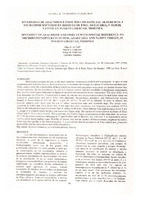Diversidad de arácnidos e insectos con especial referencia a microhimenópteros en bosques de pino, araucaria, y monte nativo, en Puerto Libertad, Misiones
Diversity of arachnids and insects with special reference to microhymenopterans in pine, araucaria and native forest, in Puerto Libertad, Misiones
Date
2005-12-01Author
De Coll, Olga del Rosario
Loiácono, Marta Susana
Eskiviski, Edgar Rafael
Faraldo, Gabriela Susana
Metadata
Show full item recordAbstract
Los microhimenópteros constituyen uno de los componentes más abundantes de los ecosistemas terrestres. A pesar de su importancia y amplia distribución permanecen taxonómica y biológicamente como uno de los grupos más pobremente conocido. Un mejor estudio, al igual que su conservación en los ecosistemas naturales y agroecosistemas, resultan imprescindibles al tratarse de especies parasitoides de insectos plaga. En razón de su distribución, de su rol como controladores biológicos y su sensibilidad a las prácticas de manejo inadecuadas, se consideran buenos indicadores en estudios para optimizar el manejo forestal sustentable. El objetivo de este trabajo es determinar la diversidad de insectos y conocer los microhimenópteros relevantes en bosques cultivados de Pinus ellioti y Araucaria angustifolia, y nativos con abundancia en el estrato arbóreo de las especies Bastardiopsis densiflora y Pelthophotum dubium, ubicados en Puerto Libertad (26° 02' 44,5" S y 540 29'13,1" O y a 297 m s. n. m.). Con tal finalidad se efectuaron muestreos periódicos, con trampas de intersección de color amarillo y trampas Moericke. Los insectos se clasificaron en órdenes y niveles menores, asimismo se analizó su abundancia y frecuencia. En todas las parcelas, los Indices de HYTD (himenópteros/trampas/días) fueron elevados en la primavera. Los Indices HYTD en nativo 1 y 2 fueron altos, excepto en noviembre la parcela de pino presentó un pico más alto. La captura de himenópteros en la plantación de P. elliotti fue 31 % en los doce meses. Este porcentaje fue levemente superior a la de los ambientes restantes. Se recolectaron un total de 2.119 microhimenópteros pertenecientes a siete superfamilias y 16 familias. Cabe señalar que la mayor diversidad de insectos correspondió al monte nativo; el número de himenópteros capturados en el monte nativo explotado fue muy similar al registrado en los foresto-ecosistemas. Se considera que las dos plantaciones de Pinus ellioti y Araucaria angustifolia, y las de monte están poco perturbadas. Microhymenopterans are one of the most abundant components of the Earth's ecosystem. In spite of their importance and wide distribution, these insects stay in taxonomy and biology as a group of the least researched ones. More studies about the conservation of these insects in nature and agriculture ecosystems are needed because they are pest parasites. By the distribution, the role in biological control, and their sensibility to inadequate management, they are, considered good indicators in studies to optimize the sustainable forest management. The aims of this work is to determine the diversity of insects and to know the relevant microhymenopterans in cultivated Pinus ellioti and Araucaria angustifolia, and native forest with abundants Bastardiopsis densiflora and Pelthophotum dubium, located in Puerto Libertad (26° 02' 44,5'' S and 54° 29'13,1''W and 297 m altitude). In order to achieve this, periodic samples were taken with the use of yellow intersection traps and Moericke traps. The insects were classified in orders and lower levels and, at the same time their abundance and frequency was analized. HYTD Indexes (himenopterans/traps/days) were high in spring, in all plots. These Indexes were high in native forest 1 and 2, except in November where the pine plot registred a higher peak. The capture of himenopterans in forests of Pinus elliotti was 31 % in twelve months. This percentage was slightly higher in comparison to the other plots. An amount of 2.119 mycohimenopterans belonging to 7 superfamilies and 16 families was collected. It is important to notice that the native forest had the major diversity of insects, and that the number of himenopterans caught on the native forest was very similar to the forest-ecosystem. It is considered, that the plantations of Pinus elliotti and Araucaria angustifolia and the native forest had a little disturbance.
Collections
- Revista Yvyraretá [360]
The following license files are associated with this item:




